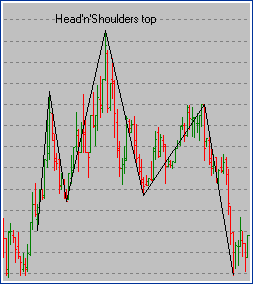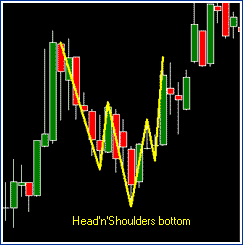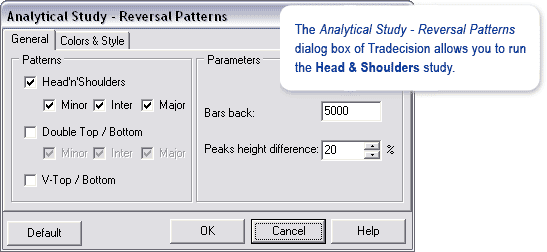Head & Shoulders: a Close-up
A Cinderella among the Nobles
Trading methods are not only different and,
most of the time, personalized ways of looking
at the market or the developments that take
place on it. In most cases, they turn into a
sort of living entities that have their own
histories and lives. Unlike some of the famous
methods, shrouded in myths and invented by some
celebrated, charismatic, and enigmatic
personalities to whom they owe their popularity,
the well-known Head & Shoulders method was
neither concocted by any controversial trading
guru nor is it promoted by the less lucky in
trading offspring of the latter, who opted for
the marketing of their great grandfather's
dubious legacy having considered the other
option of setting up a diners for the local
townies round the corner. And this is what gives
another reason to look more closely at why the
technique is so popular with so many traders.

How It Works, or You Still Need a Head on
Those Shoulders
Basically, the head & shoulders technique is
rather simple as compared to most other methods.
You don't need to painstakingly select any
inputs to train your software, measure the
planetary influence of Saturn or count the
number of successful UFO landings on it. It's
all pretty much down to earth, and, probably,
this is one the method's major merits: you can
clearly see the advantages and disadvantages of
what you entrust your hard-earned bucks to.
The Head & Shoulders pattern is comprised of
four equally important parts: the left shoulder,
the head, the right shoulder and the neckline.
The starting point for the formation of the
figure on the whole, and the left shoulder in
particular, becomes a sharp rise in the
trend-line followed by a fall, a downward
advance, and the largest volume in the pattern.
The peak volume is accounted for by the growing
number of buyers, joining in as the upward move
continues.

Now we have the left shoulder. The head is
formed by an upward and shorter advance toward
the highest peak in the formation, a fall, and a
peak volume for this part of the figure. The
right shoulder starts with a high-volume
sell-off and an upward trend. This upward trend
breaks lower than the head peak to cause the
volume to fall to the lowest point in the
pattern as the public starts awakening to the
reversal in the making. The main element in the
pattern is the neckline, drawn between the
lowermost points of the shoulders. The pattern
is complete when the neckline, being a support
line, is pierced by the right shoulder. The
"lifespan" of the pattern is normally from
several weeks to several months, and it's
unlikely to be suitable for use over the longer
haul. One the face of it, getting the hang of
the whole thing is like a cinch: definitely no
nerdy background is a requirement. But as a
thinking trader you are aware that everything
can be so simple only in that software with the
one magic button, fools spend their whole lives
looking for. Therefore, what are the pitfalls
and how to avoid them?
Identifying the Familiar Silhouette
A really big problem about the Head &
Shoulders method is that if you really want that
to happen, you'll see signs of the pattern
occurring everywhere. A sign of a true
occurrence of the pattern is a very sharp rise
in the price and a distinctly large volume this
rise is accompanied with.
Also, one should always bear it in mind that
for this specific pattern volume is of greatest
importance. A very low volume on the right
shoulder means that a reversal is happening. A
true reversal is also accompanied by the price
falling far enough below the neck-line. The
market tries to overcome the previous high,
fails to do so, and, thus, experiences the
deepest drop for the entire pattern. Most
probably, it is largely this simple,
"trustworthy", and entirely logical explanation
that the technique owes the trust many traders
put in it to. Please note, that if the price
trend-line is simply bobbing along the neckline,
you may well expect an upward move.
Another helpful sign is that the peaks of the
two shoulders should take roughly the same
amount of time to develop and be roughly of the
same height.

Overall, one can say that the possibility of
error while recognizing the true occurrences of
the pattern, especially with novice or less
experienced traders, is pretty high. The chances
can be approximately estimated as 50/50. That is
why, to reduce the related risks, it would be
expedient to use this method as an "auxiliary"
method along with the other methods you use
until you feel more confident about your pattern
recognition ability. In any case, another result
that coincides with the result of your
forecasting results will not do any harm |